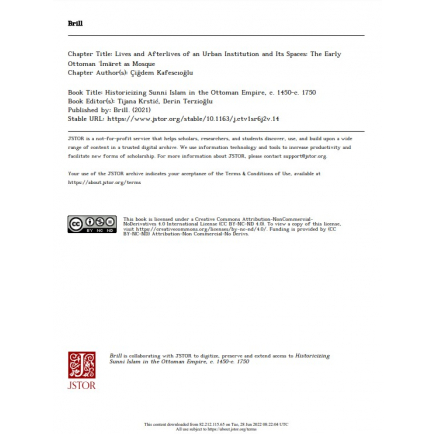
"Lives and Afterlives of an Urban Institution and Its Spaces: The Early Ottoman ʿİmāret as Mosque"
تاريخ الاضافة
28/06/2022
نوع المحتوى
Book
Category
Landscape and Urban
الرابط للمحتوى
Subject Area
Mosques
الكاتب
"Tijana Krstić
Derin Terzioğlu"
الناشر
Publisher: Brill
Year of Publication
2020
الوصف
Since the architect and restorer Sedat Çetintaş argued in 1955 that “the Green
Mosque and its likes are not mosques”1 the identity and functions of the buildings he was referring to, namely the “T-type” structures that are among the
most distinctive products of early Ottoman architectural culture, have been
matters of debate. These edifices, widely dispersed in late medieval northwestern Anatolia and the Balkans and patronized in the early centuries largely by
sultans and military leaders of the frontier zones, had plural accommodative,
social, and devotional uses. They were planned around a domed central hall,
with flanking rooms and an eyvān (Ar. īwān) across the entrance beyond the
domed hall. The eyvān, a vaulted or domed hall that opens to the central domed
space and is elevated by a few steps, was in most, but not all cases allocated to
prayer. Their foundation deeds (waqfiyya) identify them as ʿimāret or zāviye
(Ar. zāwiya), and their users as “comers and goers” (an expansive range of people in the tempestuous worlds of medieval Anatolia and Balkans), traveling
dervishes, and the needy; in royal foundations, ulama, shaykhs, sayyids (sādāt),
Quran readers, and preachers are recounted among beneficiaries. Their waqfiyyas make clear that the offering and consumption of food, social and religious ritual, and shelter provided to dervishes and travelers intersected in these
buildings constructed outside the established urban cores, initially of Bithynian and Thracian cities.





